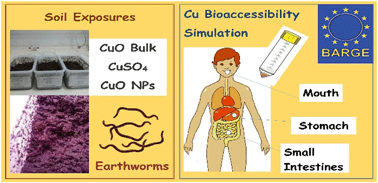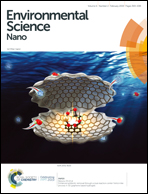Determination of the bioaccessible fraction of cupric oxide nanoparticles in soils using an in vitro human digestibility simulation†
Abstract
This study investigated the bioaccessible fractions (BAFs) of Cu from copper-based nanomaterials present in soil to humans using an in vitro artificial simulation of the stomach; followed by the simulation of the small intestinal environment. The work compared the behaviour of coated and uncoated cupric oxide nanoparticles (CuO NPs) with CuSO4 and the equivalent bulk CuO, and earthworms as a potential surrogate of human bioaccessibility. The calculated BAFs for the BGS 102 reference soil and the LUFA 2.2 soil (no added Cu) were ≤40%. In contrast, the LUFA 2.2 Cu-dosed soils measured statistically significant higher mean BAFs (ANOVA, p < 0.05); in general all above 60%. The calculated BAFs in the gastric phase did not differ statistically amongst the materials tested, both at low and high Cu dosing (ANOVA, p > 0.05). In the gastro-intestinal conditions, at the 200 mg Cu per kg soil concentration, the calculated BAFs for CuSO4, bulk and nano CuO were 76.6%, 72.7% and 83.4%, respectively, and also did not differ statistically (ANOVA, p > 0.05). At the 1000 mg Cu per kg soil concentration, only the coated CuO NPs measured BAFs > 80%; with the COOH- and PEG-coated CuO NPs significantly more bioaccessible (ANOVA, p < 0.05) than all the other Cu-based materials. In terms of human health risks from ingested soil, this study did not show significant differences between soluble and particulate forms of Cu, but Cu concentrations from the gastro-intestinal phase digestion of soil were predicted by earthworm Cu concentrations.



 Please wait while we load your content...
Please wait while we load your content...